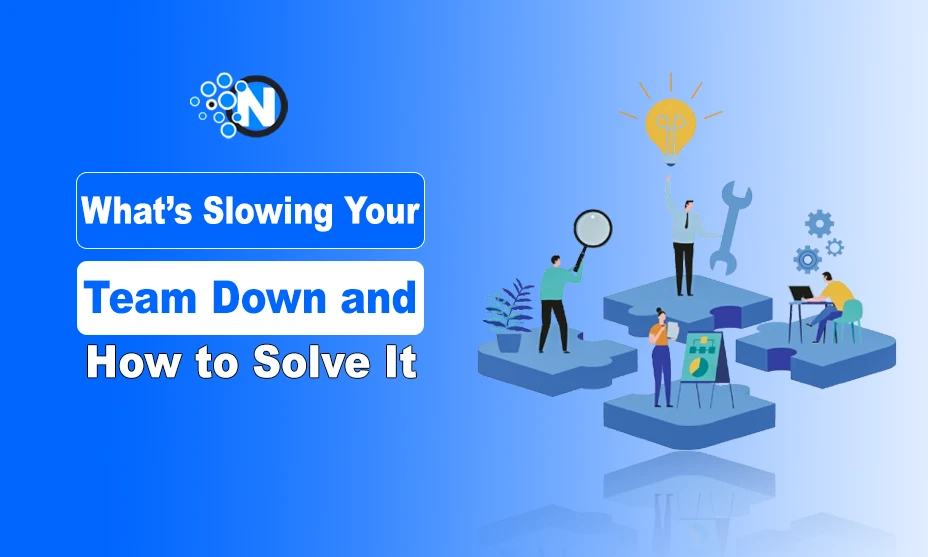What’s Slowing Your Team Down and How to Solve It?

Introduction: Appreciating the Keys Factors Inducing Low Team Performance
However, due to the increasing competition in the society, the work productivity of the teams has become a major important determinant of business performance in organizations. Yet there are barriers to team performance, and, as it is, the process is far from smooth. In this part of the paper we will discuss how to determine whether the team is productive, the symptoms of this decrease in productivity, as well as the main factors which hamper productivity.
Why is the Concept of Team Productivity Important for Business?
Team work is considered to be the basis of any effective team and thus forms the base of productivity of any organization. Coordinating work through teams allows for completing work, enlisting on tasks and projects, meeting deadlines and submitting quality work. Thus, raise in the team efficiency results in: Lower expenses, higher customer satisfaction, competitive advantage on the market and overall rise in productivity.
Symptoms That Your Work Team May Be Struggling
Being able to identify red flags is very important especially in any effort aimed at detecting underperformance at an early stage. These include, but are not limited to: Failure to meet deadlines, low spirits, many errors or mistakes made, little or no cross-over between different departments, and frequent change in employees. That is why the identification of all the above signs helps organizations implement measures that would raise the overall team performance and eliminate barriers that negatively influence its productivity.
Describing What is Costing Your Team Time
One can only imagine that failure to address the need to tackle the root cause and understanding it squarely can dent a passionate effort to correct it in the team’s productivity. In this part of the paper, we will discover that many a time, teams are let down by barriers to success that are known and could have been easily avoided, such as ineffective communication, time management problems, interferences, and lack of some skills. Having listed these factors, it is prudent that organizations come up with measures meant to address them so as to make workplace more productive.
Some of the Typical Bottleneck which Hinder Team Performance
- Poor Communication: Lack of communication increases probabilities of confusion, stringent time boost and poor discernibility of responsibilities among team members.
- Time Management Issues: Poor time management leads to time wastage, conflicts in priorities, and feeling overwhelmed throughout most of the project period.
- Workplace Distractions: Interference in terms of working environment, interruptions through emails or meetings that are not essential, loud working environment become a major drawback.
- Recognizing Skill Gaps: It may therefore be a problem when members of a group do not have ability or information required to complete their activities efficiently.
Why does the team fail to become efficient?
To be specific to team inefficiency, it is always good to work out what aspects lead to poor performance of the team. In this section, definitions of factors including absence of well-defined objectives, lack of direction with tasks, slow decision making, too much supervision, leadership void, and exhaustion of the staff shall be discussed. Therefore, if those causes are properly diagnosed, ways of fixing them can be developed to help the organizations to provide conducive environment that promotes productivity and success.
Goals and Tasks: Ambiguity of Goals and Failure in Determining Priorities
One of the methods of the efficient organization of the team is the orientation on goals and priorities. Lack of clarity about a goal or a specific goal that a team member has to meet, or how they contribute to the key objective, causes confusion and wastage of time. We describe how goal clarity and concrete task management can be maintained in order to allow for teams to concentrate on the most relevant activities, while maintaining the necessary level of alignment and efficiency.
Meeting Decisional Conflict in Groups
Reduced decision making time is always critical since it is evident that delays in decision making can have a negative impact on the overall team productivity. For a problem-solving team, lack of decision making is detrimental because it results in lost time, and overall dissatisfaction. Minimizing possible delays and encouraging extra actions can be made when the management introduces liberal decision-making approaches, employee training, and clear guidelines.
The Role of Micromanagement to Hinder Productivity
Much research has shown that micromanagement causes negative effects on productivity among the working teams. However, when employees perceive a significant level of monitoring, and if that monitoring is intrusive and overbearing, then they tend to experience reduced creativity, decision-making and drive. However, gaining the employees’ trust, delegating authority and encouraging them to be the decision maker can help you and the organization to harvest their potentialities, encourage innovations and productivity as well.
People and Talent Management: Filling Leadership Gaps
Effective leadership is highly desirable for optimisings team performance. Some leadership holes for instance direction, communication or support are common and if not well addressed, they lead to constraints which hinder a team’s performance. Organizational gaps include lack of leadership training, lack of mentorship or sponsors, and lack of communication conduit to convey organizational goals and objectives to the workforce and vice versa; these gaps can be closed to enable leaders in organizations deliver on expectations.
Employee burnout in teams: its implications for team outcomes
This is a very dangerous situation as it is evident that employee burnout can reach great heights and affect the efficiency of the whole team significantly. It becomes very hard for the team members and productivity, creativity, and morale is affected when the team members are always stressed, exhausted and disengaged. Managers can use work-life balance policies, self-care strategies, and an actively supportive organisational culture to avoid burnout, boost psychosocial well-being and increase work productivity of the employees.
First of all, one must understand that team collaboration issues must be solved.
Communication between employees of the team is one of the critical factors for high working performance. In this section, we will analyze ways to motivate team work, also to discuss about ways and means of upgrading the mode of communication among the team members, ways and means of providing technological support to remote collaboration, possible ways of motivating the team members to be accountable to their assigned tasks, And last but not the least; we will discuss about the ways of minimizing conflicts which hamper the team performances.
Some approaches for the enhancement in traffic and production.
Managing work-flow and gaining organization-productivity are among the major determinants of team-performance. In this section, we will focus on methods for how to optimize team processes and improve the use of tools for tasks and workflows, distribution of work to enhance the team’s potential, and how to use time blocking methodologies to address deadlines.
Improving Employee Turnout and Morale
Both engagement and motivation are critical issues within employee teams in organisations. In this section, we will look at more of how the management can implement recognition and reward, trust and empower its workforce, and also observe how work-life balance can minimize burnout among employees. If organisations pay attention to the staff and provide optimal working conditions, organizational commitment, productivity and general performance of the groups will improve.
Conclusion
Getting the most out of your team means that there should be a step by step approach to the methods that seek to make teamwork better, the ways in promoting better flow and increasing the degree of satisfaction among the employees. If the strategies in the article are adopted, the various teams will ensure that the culture is productive, collaborative, and successful.
Through proper channeling of communication channels as well as implementing the use of technology in the processes of online working, different groups of working employees are able to do away with geographical barriers in information exchange. Engaging accountability helps each member of the team to feel ownership and responsibility in the business hence the personal and group improvement.







